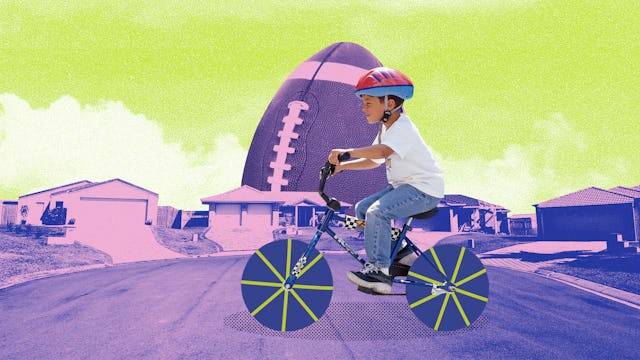We Accidentally Found The Best Way To Recreate An 80s Childhood
We stumbled into a free-play utopia.

We moved onto a cul-de-sac seven years ago because the right house just so happened to be on one. With nowhere to park, the moving truck sort of hovered in the middle of the big loop into which six driveways fed. I was new to motherhood, my oldest son an infant in the crook of my arm, and so I had no idea that he and his siblings would log more hours out in that big loop than they would inside the house we had so carefully chosen. I had no idea that they would run barefoot into the street crowing out calls to the neighbor kids and slapping down bases to see how many innings they could squeeze in before supper. I had no idea how many birthday candles would be blown out in that street — the inhale, the puffed cheeks, the smoke rising amid cheers of friends we’d love all our lives. I had no idea.
The French word cul-de-sac means bottom of the sack, shaped like Santa’s magical bag, which is apt, since its tricks are endless. A study from the University of California-Davis showed that kids who live on cul-de-sacs play outside more, which we have proven with every Nerf bullet in the trees, with every Frisbee that has slid into the drain, with every one of the 22 bike laps it takes to go a mile around the Shorts’ driveway.
At the ends of the other five driveways live members of the herd of thirteen children we’ve deemed the sac pack, who swarm in the street and blaze paths from yard to yard, who hide out in patches of azalea bushes, who come down from the magnolia trees wild-haired, dirty, and almost indistinguishable from each other. If your last name is Hofer, come home! I’ll yell from the front porch, and watch my children pad reluctantly up the driveway at the end of the day.
Cul-de-sacs may seem aggressively suburban, designed by dated developers trying to make use of land not suited for a grid street pattern, but they are not all out in the boondocks. We live only a few minutes from downtown Raleigh, N.C., a midsized city with the third hottest job market in America, according to the Wall Street Journal. Still, this is very much the South, where cups of sugar and hand-me-down dress shoes flow from house to house, where if one of us makes too much casserole, the rest of us will find Tupperwares by our side doors.
There’s an intimacy to the whole arrangement. Every car that comes onto our street is visiting one of the six of us or is lost.
Sure, we might be the last street to get the snow plow or the garbage pick-up. We might be more prone to baseballs-through-windows and mailbox replacements (two and counting for us). But we have a canvas like no other for chalk masterpieces, a stage for freeze dance in the rain, a venue for pizza parties and foot races and all the communion of a college dorm.
It was dumb luck, living here, in this nostalgic utopia of free play. And the play isn’t only for the children. What better friends have I than the other ‘sac adults — we who have seen each other every day and in every way, who sit shoulder-to-shoulder for curb beers in the evening and curb coffees the next morning? I know we won’t all always live here. The children will outgrow their obstacle courses and street soccer games. One day, someone else will get their chance to discover the best sledding route down our driveway, the old bike path behind the Moriseys’ house, and the tree in the Brooks family’s yard that glows gold every fall. But if it’s the fellowship that matters the most, then I have hope that we can create our own cul-de-sacs wherever we are.
A cul-de-sac is literally a route leading nowhere, but for our children, who are growing up fueled by uninhibited outdoor play and the powerful friendships that have followed… for them, the cul-de-sac leads everywhere.
Hampton Williams Hofer lives in Raleigh, North Carolina, where she writes and raises babies. Her work has appeared in Flying South, Walter Magazine, Architectural Digest, and Food 52, among others. Family aside, her great loves are a South Carolina beach, a Roger Federer backhand, a Charlottesville lawn, and–most of all–a good story.
This article was originally published on